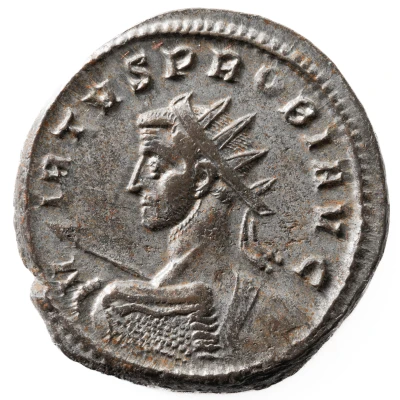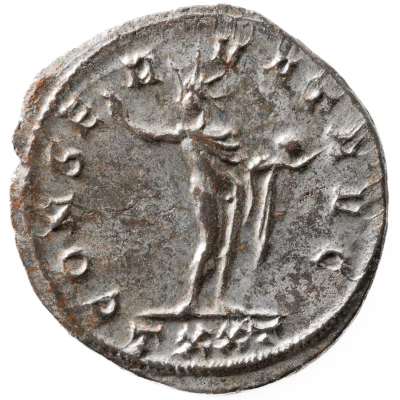


© PrimeME
Antoninianus - Probus F19 bust; CONSERV T AVG; Sol
278 year| Silver | 4.23 g | 23.77 mm |
| Issuer | Rome › Roman Empire (27 BC - 395 AD) |
|---|---|
| Emperor | Probus (Marcus Aurelius Probus) (276-282) |
| Type | Standard circulation coin |
| Year | 278 |
| Value | Antoninianus (1) |
| Currency | Antoninianus, Reform of Caracalla (AD 215 – 301) |
| Composition | Silver |
| Weight | 4.23 g |
| Diameter | 23.77 mm |
| Shape | Round (irregular) |
| Technique | Hammered |
| Demonetized | Yes |
| Updated | 2024-10-05 |
| Numista | N#293463 |
|---|---|
| Rarity index | 97% |
Reverse
Sol, radiate, standing front, head left, raising right hand and holding globe in left hand.
Script: Latin
Lettering:
CONSERVA AVG or CONSERVAT AVG
-/-//TXXT
Translation:
Conservatori Augusti.
Protector of the emperor.
Comment
This coin was minted by the 3th officina (exergue mark TXXT) of Ticinum, as part of the 4th emission and therefore in the year 278 (Karl Pink, Der Aufbau der römischen Münzprägung in der Kaiserzeit VI/I, Wien, 1949).This coin depicts the F19 bust of Probus (Bust type according to Pierre Bastiens grouping of bust types): bust of Probus, radiate, heroically nude, left, seen from behind, holding spear in right hand and square shield (aegis) in left hand.
The F19 bust is not in RIC at all. RIC sometimes mentions a 'square shield' (for example: RIC 388) or even an 'aegis' (for example: RIC 296). However it always mentions Probus 'cuirassed' while the F19 bust is '(heroically) nude'.
See for other examples of this RIC 351-variant with a F19 bust: (probuscoins.fr #281); (probuscoins.fr #344); (probuscoins.fr #1128)
There is a second variant of RIC 351 known with an E8 bust (see: probuscoins.fr #1086). The only difference between the F19 and E8 bust is that the E8 bust is helmeted.
Interesting fact
One interesting fact about the Antoninianus - Probus coin is that it was issued during a time of economic reform and military campaigns. The coin's design features the emperor Probus, who ruled from 276 to 282 AD, and the inscription "CONSERVATOR AVG," which translates to "Conservator of the Emperor." This suggests that the coin was minted during a period of political and economic stability, which was a significant achievement during a time of great turmoil in the Roman Empire. Additionally, the coin's silver content and weight of 4.23 grams indicate that it was a valuable and widely used denomination in the Roman economy.
![Antoninianus - Probus Helmeted, cuirassed, left, spear and shield; CONSERVA[T] AVG; Sol front](/storage/images/Antoninianus-Probus-Helmeted-cuirassed-left-spear-and-shield-CONSERVAT-AVG-Sol_292701_1.webp)
![Antoninianus - Probus Helmeted, cuirassed, left, spear and shield; CONSERVA[T] AVG; Sol back](/storage/images/Antoninianus-Probus-Helmeted-cuirassed-left-spear-and-shield-CONSERVAT-AVG-Sol_292701_2.webp)